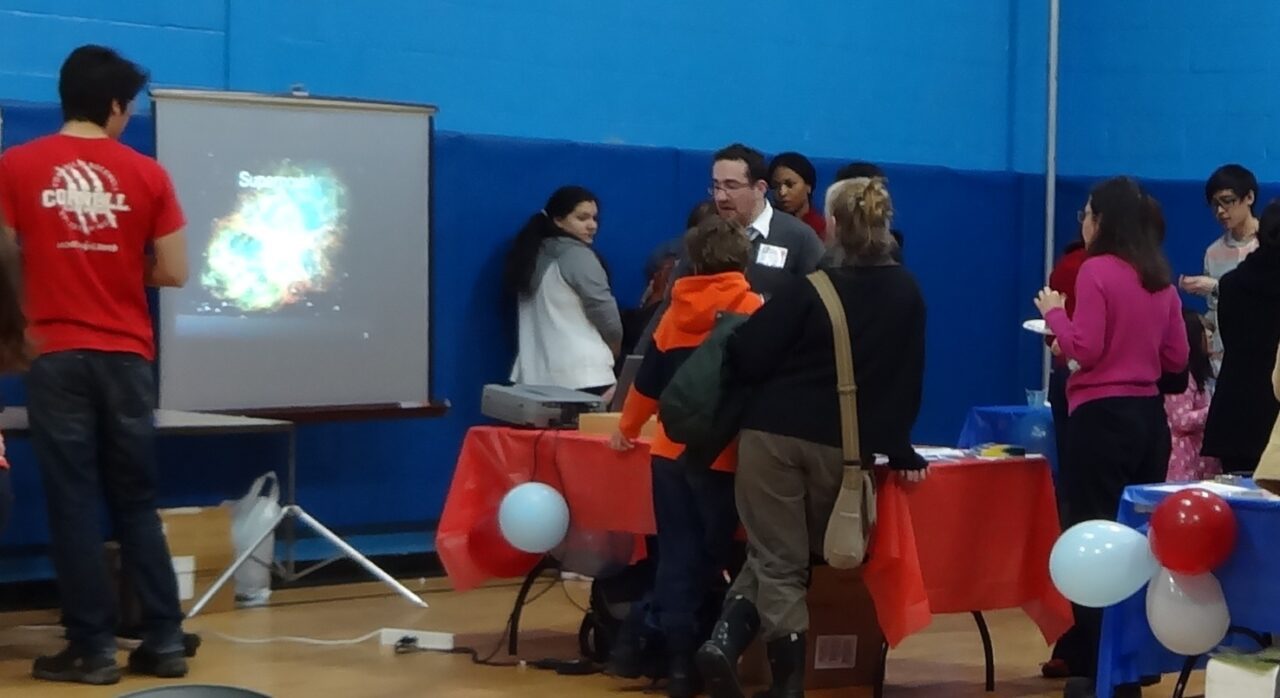Science Day in Ithaca
February 22nd, 2014 | Ithaca, NY, United States
On Saturday, February 22, an entertaining and informative event took place at the Greater Ithaca Activities Center (GIAC) in downtown Ithaca. It was a rewarding experience, as things often are when different organizations with missions to support their community decide to work with each other to create a collaborative event of activities for everyone!
Organized by the Cornell Chapter of the Society of Hispanic Professional Engineers, the exposition was geared especially toward the local Latino community but open to all. They invited Celebrate Urban Birds to set up a space to promote citizen science and birds among all the young students and engineers from various programs at Cornell University. Together, all the different projects—from DNA analysis to bridge-building to astrophysics—showed local visitors the wonders of science and, for the younger members of the audience, the fantastic possibilities for future avenues of study and careers.
(Photo © Marta del Campo)


The student organizers of the event were full of positive energy and willingness to share their vision of the accessibility of science. Their small demonstrations, often hands-on for participants, helped make the complex theory behind certain engineering principles easier for everyone to understand and experience for themselves. For our own part, we tried to give people an idea of the birds that live around us in urban areas and how we can appreciate and help them!
(Photo © Marta del Campo)
We were able to open a window into the often unseen lives of birds in the spring by bringing actual bird nests to GIAC, along with photos of the species that made them. The goal was to get people excited about heading out into the fresh air and looking for these crafted signs of spring in the upcoming months, even in urban Ithaca. Kids and adults alike were awed by the extraordinary construction skills displayed by birds, asking questions like, “What materials do they use?” “How can the Baltimore Oriole weave without hands?” “Where do American Robins nest?” and “Do Blue Jays mix up all the different types of nesting material together on purpose?”
(Photo © Marta del Campo)

These types of questions showed us how fascinating people found the feats of engineering embodied in the careful and dedicated work of bird nests. It’s not every day that you get to see the majestically woven basket nest of a Baltimore Oriole—much less gently touch it! By seeing these wonders up close, we hope both the adults and kids who visited our station will be keeping an eye out for the nests that are invariably built around them in a green city like Ithaca: nature is just around the corner!

With support from the Museum of Vertebrates at the Cornell Lab of Ornithology, we were also able to take a small sample of the hundreds of specimens of birds in the collection to show visitors, and it was a great success. People who stopped by our table were stunned by the elegant beauty of the Rose-breasted Grosbeak and the lustrous black feathers of the American Crow, as well as the other half-dozen species we brought out. In addition to these real-life bird examples, we brought our CUBs materials on bird-friendly gardening and focal species posters, including Lemon Queen Sunflower seeds for people to take home and plant on their balconies or in their backyard. Hopefully they’ll grow into urban beautifiers that will also help local bird life!
(Photo © Marta del Campo)
It was really wonderful to see how interested and curious the families who visited each table at the Science Day exposition were, as well as how engaging the student volunteers from Cornell could be on an early Saturday morning. Most of the stations had interactive presentations to reach people of all ages and regardless of scientific background knowledge. For example, the textile research group had some microscopes hooked up to a digital screen so that people could look at the minuscule details of fibers and fabrics, as well as other interesting things like grasshoppers, twigs, and of course the Baltimore Oriole nest we brought!
(Photo © Marta del Campo)


The astronomers had a table dedicated to wonders of the universe such as supernovas, suns, and planets, making the day a series of marvels from the microscopic to the macrocosmic, all brought within reach of everyone visiting GIAC.
Thanks to the Cornell Chapter of the Society of Hispanic Professional Engineers, students were able to share nature’s fascinating forms, and the ways in which we study them, with local Ithaca residents who otherwise might not always be able to learn about Cornell’s research programs. Hopefully this will become a yearly event to stimulate curiosity, generate interest in technological innovation and scientific research, and celebrate community. Thank you to all the volunteers who invited us to participate and made this day of science-sharing happen!
(Photo © Marta del Campo)